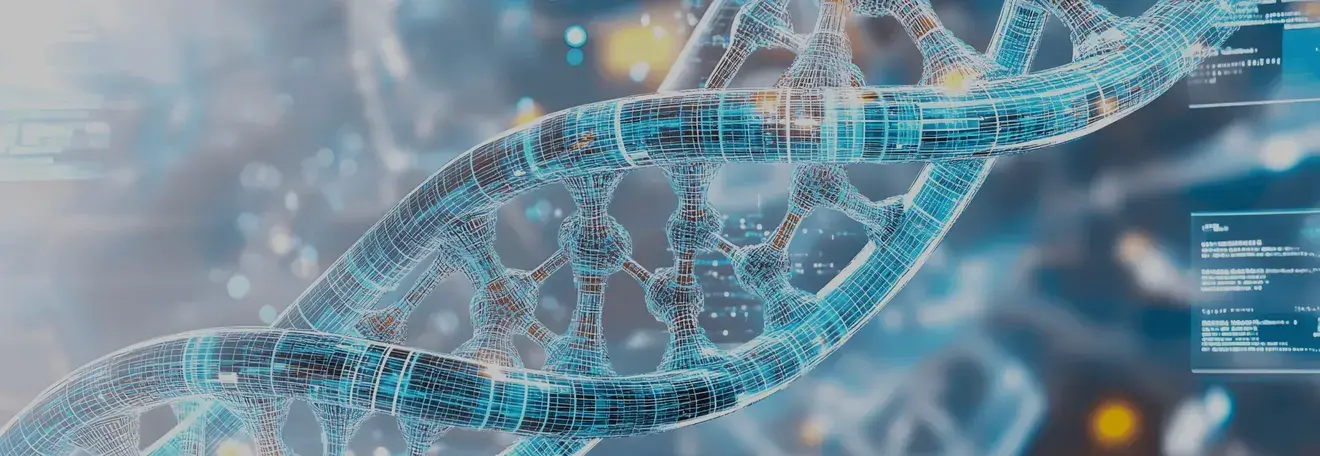From drug discovery to improved patient outcomes, data analytics is transforming life sciences, making data-driven insights essential for innovation and patient care. Dive into this article to explore the use cases, technologies, and strategies setting the course for the industry's future.
In the fast-paced world of life sciences, data has become the new lifeblood of innovation. From drug discovery to personalized medicine, data analytics is revolutionizing how we approach healthcare and research. And many companies are turning to analytics to make smarter, faster decisions.
The global life science analytics market is projected to grow from $11.97 billion in 2025 to approximately $24.85 billion by 2034, reflecting a CAGR of 8.47%. This remarkable growth underscores the realization that data-driven insights are no longer optional—they’re essential for staying competitive and achieving better outcomes.
Are you ready to explore how data analytics can unlock the future of healthcare? Dive into the use cases, benefits, and technologies shaping the life sciences industry and discover how your organization can thrive with data-driven solutions.
What is Life Science Data Analytics?
The term refers to collecting, analyzing, and interpreting vast amounts of biological and healthcare data. It combines advanced statistical techniques, machine learning algorithms, and domain expertise to extract meaningful patterns from clinical trials, electronic health records, genomics data, imaging data, and real-world data from many sources, including wearables and medical devices.
This process transforms raw data into actionable insights that drive drug development, personalized medicine, and improved health outcomes.
Use Cases of Data Analytics in Life Science
The impact of data analytics in the life sciences is paramount and continues to grow rapidly. Organizations are now using big data to drive scientific discoveries and optimize their operations. According to a McKinsey report, data analytics can generate $60 billion to $100 billion in economic benefits for the global healthcare industry annually. Let’s look at some key use cases where it is transforming life sciences.

Drug Discovery and Development
This is where data analytics really shines, helping researchers bring life-saving treatments to market faster and more efficiently.
Target Identification and Validation
Data analytics is revolutionizing the early stages of drug development. It helps pinpoint potential drug targets by analyzing biological pathways and genetic data. Imagine AI algorithms sifting through massive datasets to find biomarkers associated with specific diseases—like finding a needle in a haystack, but much, much faster.
Compound Screening
Forget the old-school trial-and-error methods. Predictive models can now screen millions of compounds to identify the most promising candidates for further testing. It’s like having a super-powered detective that can predict the efficacy and toxicity of compounds based on historical data. The company will significantly reduce the time and resources required for early-stage drug development.
Clinical Trials Optimization
Data analysis in life sciences optimizes the design and execution of clinical trials, identifying suitable patient populations and predicting trial outcomes. This means finding the right people for the right trials, identifying how patient groups respond to a new therapy, and reducing costs and time—a win-win for everyone.
Genomics
Think of genomics as the study of your body’s instruction manual - your DNA. Data analytics helps us decipher this complex code. Analyzing large-scale genomic data helps us understand genetic variations and their associations with diseases. For example, analyzing whole-genome sequencing data can find cancer-related mutations, leading to earlier diagnosis and personalized treatment. Data analytics is also accelerating advancements in mRNA technology and CRISPR gene editing: a more precise and efficient therapeutic developments become possible.
Clinical Trials and Research
Patient Recruitment
Finding the right participants for clinical trials is crucial yet challenging. Data analytics tools now mine electronic health records (EHRs) to identify patients who meet specific trial criteria. This not only speeds up the recruitment process but also ensures a more diverse and representative patient population in clinical studies.
Data Monitoring and Management
Real-time data monitoring in clinical trials has become a reality. Automated systems can now flag abnormal patterns in patient data, allowing for timely interventions and ensuring trial integrity. This continuous monitoring enhances patient safety and improves the overall quality of clinical research.
Epidemiology and Public Health
Ever wonder how health officials track disease outbreaks and plan public health initiatives? Data science for life sciences plays a crucial role here.
Disease Surveillance
Predictive models now track the spread of infectious diseases like COVID-19 by analyzing data from various sources, including social media, EHRs, and public health databases. This real-time surveillance enables public health officials to respond swiftly and effectively to emerging health threats.
Population Health Management
Analyzing population data helps identify health trends and plan targeted public health initiatives. For example, using AI tools, researchers can analyze large-scale health data and identify regions with high rates of chronic diseases, allocate healthcare resources more efficiently, and improve public health indicators.
Pharmacovigilance
Ensuring drug safety doesn’t end with clinical trials, and life sciences software for data analytics helps keep a watchful eye on medications even after they hit the market. It helps analyze patient data and reports to detect and investigate adverse drug reactions. Machine learning models can process patient feedback to identify potential drug safety issues early on, protecting patients and improving drug development.
Real-World Evidence (RWE)
Data analytics helps us understand how treatments work in real-world settings, beyond the controlled environment of clinical trials.
Post-Market Surveillance
Collecting and analyzing real-world data allows us to monitor the safety and efficacy of drugs after their market release. For example, EHR data is used to track the long-term effects of a new medication in diverse patient populations, providing valuable insights beyond controlled clinical trials.
Comparative Effectiveness Research
Which treatment works best for whom? Data analytics helps compare the effectiveness of different treatments using real-world data. This means we can analyze the outcomes of patients using different medications for a specific condition, like diabetes, to determine the most effective treatment option.
Operational Efficiency in Laboratories
Automation and Workflow Optimization
Life sciences data analytics make laboratories smarter and more efficient. Automated systems can now optimize sample processing workflows, reducing turnaround times, minimizing errors, and ensuring that labs operate efficiently and accurately. This not only improves productivity but also enhances the quality and reliability of laboratory results.
Quality Control
Real-time analytics systems can now detect deviations in lab results, prompting immediate corrective actions and ensuring accurate and reliable results. This continuous monitoring ensures consistent quality and compliance with regulatory standards, crucial for both research integrity and patient safety.
Predictive Informatics
The integration of predictive modeling and informatics is enhancing decision-making in healthcare, pharmaceutical, and life sciences industries by aggregating and analyzing diverse data types to forecast outcomes.
Data Analytics Technologies Driving Life Science
The rapid advancement of life sciences requires adopting cutting-edge technologies. Let’s explore the key tools and technologies enabling this data-driven revolution in healthcare and biotechnology.

1. Big Data in Life Sciences
Hadoop and Spark
Frameworks like Hadoop and tools like Spark allow the storing and processing of massive datasets, allowing life sciences researchers to handle large-scale genomic data, clinical trial data, and other types of biomedical information efficiently. These technologies can process petabytes of data, making it possible to analyze entire populations’ health records simultaneously.
NoSQL Databases
Traditional relational databases can’t handle the diverse and unstructured data often used in life science research. NoSQL databases, such as MongoDB and Cassandra, excel at storing and searching complex biological data and allow scientists to manage and analyze data types such as genetic sequences, medical images, and patient records, offering the flexibility to work with complex datasets.
2. Artificial Intelligence and Machine Learning
Deep Learning
The AI in life sciences market is anticipated to experience a remarkable CAGR of around 25% in the coming years. The growing trend highlights the increasing reliance on AI technologies across various applications in life sciences. Neural networks and deep learning algorithms are used for image analysis (e.g., medical imaging, pathology slides), predicting disease outcomes, and identifying potential drug candidates. For instance, deep learning models can analyze thousands of medical images to detect early signs of diseases like cancer with accuracy rivaling human experts.
Natural Language Processing
NLP helps extract information from unstructured data sources such as scientific articles, clinical records, and electronic health records (EHRs). This technology helps life science organizations transform them into data that can be used to improve clinical decision-making and accelerate research. In addition, it can sift through millions of scientific publications and identify emerging trends or potential drug interactions, accelerating discovery.
Predictive Analytics
In predictive analytics, machine learning models forecast patient outcomes, disease progression, and treatment responses based on historical data. These models can analyze them and forecast which patients are at high risk for certain conditions, enabling proactive interventions and personalized treatment plans. They also help healthcare professionals make data-driven decisions, personalize treatment plans, and improve patient outcomes.
3. Genomic Technologies
Next-Generation Sequencing (NGS)
Next-generation sequencing technologies generate enormous volumes of genetic data, which require advanced life sciences data analytics tools to interpret and understand variations and mutations. These tools can sequence an entire human genome in just a few hours, a process that once took years—it’s a revolution in understanding genetic diseases. By analyzing NGS data, researchers can open up new opportunities for patient-specific treatment and gain a deeper understanding of complex diseases such as cancer.
CRISPR and Gene Editing Data Analysis
Data analytics tools help analyze outcomes of gene editing experiments, understand off-target effects, and optimize gene therapies. CRISPR and similar technologies guide precise gene editing and improve therapeutic effectiveness. These tools are crucial in ensuring the safety and efficacy of revolutionary treatments like CAR-T cell therapy for cancer.
4. Cloud Computing
Scalable Computing Resources
Cloud platforms like AWS, Google Cloud, and Microsoft Azure provide scalable computing power and storage solutions, making managing and analyzing large datasets easier. Researchers can analyze large datasets without extensive on-premises infrastructure, enabling more efficient life sciences data management and faster results. This allows even small research labs to access supercomputer-level processing power on demand.
Data Integration and Collaboration Tools
Cloud-based tools facilitate the integration of diverse data sources, such as EHRs, genomic data, and lab results. They also enable collaboration among researchers across different locations, driving global innovation in life sciences research. For example, they played a crucial role in the rapid development of COVID-19 vaccines.
5. Data Visualization
Interactive Dashboards
Visualization tools like Tableau, Power BI, and D3.js create interactive dashboards that make complex data trends and patterns more accessible. These dashboards can transform millions of data points into intuitive visual representations, helping researchers and clinicians identify key insights, understand complex life sciences data trends and patterns, and make data-driven decisions in real time.
3D Visualization
Advanced 3D visualization techniques help life sciences professionals visualize molecular structures, anatomical models, and more. These tools allow researchers to virtually “walk through” complex biological structures, aiding in drug design and surgical planning. It is particularly helpful in drug discovery and understanding biological mechanisms at a structural level, leading to more accurate treatments.
6. Internet of Things (IoT) and Wearables
Remote Patient Monitoring
Wearable devices and IoT sensors continuously collect health data. In turn, they can be analyzed in real time to monitor patient health and detect potential health issues early. This technology plays a critical role in managing chronic diseases and improving patient adherence to treatment plans. It enables the shift from reactive to proactive healthcare, potentially saving millions of lives.
Telemedicine
Telemedicine platforms leverage IoT technology to facilitate remote consultations between patients and healthcare providers. This technology expands access to healthcare services, particularly in underserved areas. The insights gained from telemedicine consultations help healthcare providers personalize care and streamline services, ensuring more efficient and accessible healthcare.
7. Bioinformatics Tools
Sequence Alignment and Analysis
Bioinformatics tools like BLAST and Clustal Omega are used for sequence alignment, phylogenetic analysis, and identifying genetic markers. These tools allow researchers to identify genetic markers and compare genetic sequences across species. It will help researchers understand evolutionary relationships and identify potential therapeutic targets, advancing personalized medicine and developing targeted therapies.
Protein Structure Prediction
Tools like AlphaFold use machine learning algorithms to predict protein structures based on amino acid sequences. These models are revolutionizing drug design and biological research. They help researchers understand how proteins fold and function, enabling more precise drug targeting and advancing our knowledge of complex biological systems.
Benefits of Integrating Data Analytics Solutions
The integration of data analytics into the life sciences sphere is driving significant progress, empowering organizations to make smarter decisions and accelerate innovation. Let’s consider some key benefits:
- Improved decision-making: Data analytics empowers researchers and healthcare professionals to draw valuable insights from massive amounts of data. Using predictive models and real-time analysis, scientists can make more informed choices, reducing risks and improving outcomes in research and clinical settings.
- Faster drug discovery and development: With faster analysis of large data sets, researchers can quickly identify promising drug candidates, reducing the time it takes to bring new treatments to market.
- Reduced costs: Data-driven insights streamline processes, reducing inefficient costs in research, clinical trials, and patient care. By optimally allocating resources, researchers can save money by implementing more innovative projects.
- Improved research and innovation: Advanced analytical tools allow researchers to discover hidden patterns in complex biological systems. This capability accelerates scientific discovery, facilitates the development of new treatments, and opens up new avenues for personalized medicine.
- Improving healthcare and epidemiology: Healthcare organizations can better track disease outbreaks and predict trends. By analyzing population health data, they can implement proactive interventions, improving public health outcomes and reducing the spread of infectious diseases.
Examples of Data Analytics Applications
Do you recall that a COVID-19 vaccine was developed in just 11 months, compared to the typical 10–15 years for vaccine development? Or that artificial intelligence can now detect certain types of cancer before symptoms even appear? These real-world examples showcase how data-driven life science approaches are revolutionizing life sciences. Let’s dive into these fascinating cases that are changing the face of healthcare and research.
Pfizer and COVID-19 Vaccine Development
Remember the race to develop a COVID-19 vaccine? By leveraging advanced analytics, Pfizer rapidly processed vast amounts of clinical trial data, enabling real-time decision-making. Predictive models identified potential side effects early, ensuring safety without compromising speed. This data-driven approach resulted in one of the fastest vaccine rollouts in history, a crucial factor in managing the global pandemic.
IBM Watson for Oncology
IBM Watson for Oncology stands as a beacon of hope in cancer treatment. This AI-powered system digests millions of medical journal articles, clinical trial data, and patient records to suggest personalized treatment options based on the latest scientific evidence. This helps doctors make more informed decisions, potentially improving patient outcomes and increasing survival rates.
GRAIL’s Early Cancer Detection
GRAIL is pioneering a revolutionary approach to cancer detection. Their blood test, powered by sophisticated algorithms, can detect cancer’s faintest samples in the bloodstream before symptoms appear. By analyzing fragments of tumor DNA, GRAIL’s technology can identify multiple cancer types at early stages. This groundbreaking approach could redefine cancer diagnosis, shifting the paradigm from treatment to prevention and dramatically improving survival rates.
Flatiron Health’s Real-World Evidence Platform
Flatiron Health’s innovative platform is bridging the gap between clinical trials and real-world outcomes. By aggregating and analyzing data from millions of cancer patients, Flatiron provides unprecedented insights into treatment effectiveness outside controlled trials. This real-world evidence is reshaping drug development, regulatory decisions, and patient care. Researchers can now identify trends, optimize treatment protocols, and accelerate drug development, ultimately bringing more effective therapies to patients faster.
LIMS for Biotech Company by Coherent Solutions
Coherent Solutions partnered with a leading healthcare provider to develop a new-generation Laboratory Information Management System (LIMS). In just one year, they transformed the system’s architecture, dramatically boosting performance and stability. This system revolutionized the management of laboratory research data, resulting in a more efficient process for handling histology materials and improved overall system performance. This improvement streamlined workflows, reduced errors and accelerated research timelines.

Challenges and Considerations When Implementing Data Analytics in Your Processes
After exploring the incredible potential of data analytics, you might assume that everything would be smooth sailing. While the benefits are dramatic, the road to data-driven innovation is not without its obstacles. Let’s dive into the challenges that keep data scientists and life sciences professionals awake at night, as well as the considerations that are critical to success in this data-driven revolution.
-
Data Privacy and Security: Managing sensitive health data requires strict adherence to privacy and life sciences data security protocols. Breaches of patient data can result in legal issues and a loss of trust. Ensuring compliance with regulations like GDPR and HIPAA is critical to maintaining data integrity.
-
Data Quality and Integration: Data often comes from disparate sources, such as lab results, EHRs, and clinical trials, which may vary in quality and format. Integrating these diverse datasets and ensuring their accuracy can impact the reliability of data-driven decisions.
-
Technical Challenges: Implementing advanced systems requires high-performance computing infrastructure, complex algorithms, and cutting-edge technologies. These technical demands can pose significant challenges, particularly for organizations without the necessary IT resources or expertise to handle big data and real-time analytics.
-
Regulatory and Ethical Issues: Strict regulatory frameworks govern life sciences, making compliance with various laws and guidelines a complex task. Furthermore, the ethical use of patient data, especially when using AI for decision-making, raises concerns about fairness, transparency, and patient consent.
-
Reproducibility and Validation: Ensuring the reproducibility of scientific results is crucial in life sciences, but data analytics models can sometimes produce inconsistent results. Validating the accuracy and reliability of predictive models requires rigorous testing and robust datasets, making it a major challenge for researchers.
-
Skill Gaps: The interdisciplinary nature of life sciences data analytics requires a unique blend of skills spanning biology, statistics, and computer science. Many organizations struggle to find and retain professionals with this diverse skill set, creating a talent gap that can hinder the adoption and effective use of data analytics.
Skilled Data Analysts by Your Side
Ready to unlock the power of your data? At Coherent Solutions, we’re passionate about transforming complex data into actionable insights. With 30 years of expertise, we offer a full range of advanced data analytics services that help life sciences organizations achieve better outcomes, spark innovation, and stay ahead in an ever-evolving industry.
Why Clients Choose Us
-
Proven Impact, Tangible Results: With a 95% customer retention rate and three decades of expertise, we consistently deliver reliable, future-ready solutions across core technologies.
-
Healthcare Expertise You Can Rely On: Our deep expertise in the life sciences industry ensures we understand the complexities of healthcare data.
-
Focus on Innovation: Our technological competitive advantage positions us at the forefront of innovation.
FAQs on Data Analytics Use in Life Sciences
-
Data analytics helps life sciences organizations extract insights from large, complex datasets to drive drug discovery, clinical trials, patient care, and regulatory compliance.
-
The global life science analytics market is valued at approximately $11.97 billion in 2025, with projections to reach $24.85 billion by 2034.
-
Notable use cases include predictive modeling in clinical trials, real-world evidence analysis, pharmacovigilance, genomics-based precision medicine, and supply chain optimization.
-
AI accelerates data processing, improves predictive accuracy, and supports innovations like mRNA therapy development, CRISPR research, and early disease detection through pattern recognition.
-
Challenges include data privacy and compliance concerns, managing heterogeneous data sources, and the ongoing shortage of cross-functional talent with both domain and technical expertise.



